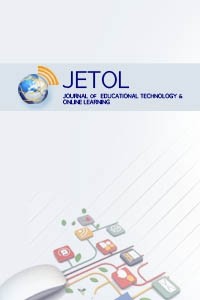İçerik İpuçlarını Kullanarak İkinci Dilde Kelime Öğrenme: Son On Yılda Yapılan Çalışmaların İncelenmesi ve Dijital Ortamdaki Uygulamaları
İçerik ipuçları, kelime öğrenme, okuma etkinliği, ikinci dil öğrenimi
Second Language Vocabulary Learning From Context Clues: A Review of Research in the Past Decade and Implementation in Digital Environment
Context clues vocabulary learning, reading, second language acquisition, digital learning,
___
- Cobb, T. (1999). Breadth and depth of vocabulary acquisition with hands-on concordancing. Computer Assisted Language Learning, 12(4), 345-360.
- Davies, Mark. (2008-) The Corpus of Contemporary American English (COCA): 560 million words, 1990-present. Available online at https://corpus.byu.edu/coca/.
- Ebrahimain, A. & Nabifar, N. (2015). The effect of three vocabulary learning strategies of word-part, word-card and context-clue on Iranian high school students’ immediate and delayed English vocabulary learning and retention. The Journal of Applied Linguistics, 8(17), 42-63.
- Elgort, I. & Warren, P. (2014). L2 vocabulary learning from reading: Explicit and tacit lexical knowledge and the role of learner and item variables. Language Learning, 64(2), 365-414.
- Folse, K. S. (2004). Vocabulary myth: Applying second language research to classroom teaching. Ann Arbor: The University of Michigan Press.
- Golonka, E. et al. (2015). The Role of Context and Cognitive Effort in Vocabulary Learning: A Study of Intermediate‐Level Learners of Arabic. The Modern Language Journal, 99(1), 19-39.
- Hamada, M. (2014). The role of morphological and contextual information in L2 lexical inference. The Modern Language Journal, 98(4), 992-1005.
- Horst, M., Cobb, T. & Nicolae, I. (2005). Expanding academic vocabulary with an interactive on-line database. Language Learning & Technology, 9(2), 90-110.
- Johns, T. (1991). Should you be persuaded: Two samples of data-driven learning materials. ELR Journal, 4, 1–16.
- Karbalaei, A., Amoli, F. A. & Tavakoli, M. M. (2012). The effects of explicit teaching of context clues at undergraduate level in EFL and ESL context. European Online Journal of Natural and Social Sciences, 1(3), 68-77.
- Ko, M. H. (2012). Glossing and second language vocabulary learning’. TESOL Quarterly, 46(1), 56-79.
- Kondo‐Brown, K. (2006). How do English L1 learners of advanced Japanese infer unknown kanji words in authentic texts?. Language Learning, 56(1), 109-153.
- Mestres-Missé, A., Münte, T. F. & Rodriguez-Fornells, A. (2014). Mapping concrete and abstract meanings to new words using verbal contexts. Second Language Research, 30(2), 191-223.
- Mestres-Missé, A., Rodriguez-Fornells, A. & Münte, T. F. (2007). Watching the brain during meaning acquisition. Cerebral Cortex, 17(8), 1858-1866.
- Pigada, M. & Schmitt, N. (2006). Vocabulary acquisition from extensive reading: A case study. Reading in a foreign language, 18(1), 1-28.
- Van Assche, E., Duyck, W. & Brysbaert, M. (2013). Verb processing by bilinguals in sentence contexts: The effect of cognate status and verb tense. Studies in Second Language Acquisition, 35(2), 237-259.
- Webb, S. (2008). The effects of context on incidental vocabulary learning. Reading in a Foreign Language, 20(2), 232-245.
- Yoon, H. & Hirvela, A. (2004). ESL student attitudes toward corpus use in L2 writing. Journal of Second Language Writing, 13, 257-283
- ISSN: 2618-6586
- Yayın Aralığı: Yılda 3 Sayı
- Başlangıç: 2017
- Yayıncı: Gürhan DURAK
LEGO MINDSTORMS EV3 ROBOT PROGRAMLAMA ARAYÜZÜNÜN İNCELENMESİ
Çevrimiçi Yabancı Dil Öğrenme Ortamı Örneği: VoScreen
Mobil Öğrenmede Güncel Çalışmalara Yönelik İçerik Analizi
Abdulvahap Sönmez, Lütfiye Göçmez, Derya Uygun, Murat Ataizi
